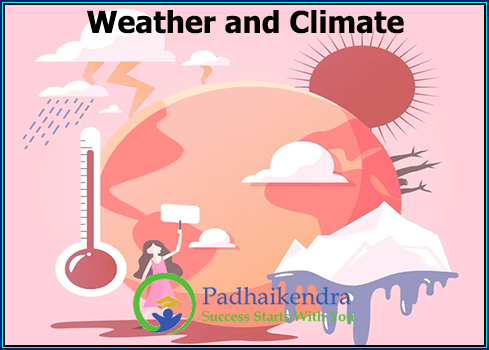Weather and climate are two related but distinct concepts in atmospheric science. Weather refers to the short-term atmospheric conditions in a specific region, including temperature, humidity, precipitation, wind, and cloud cover, while Climate refers to long-term patterns and trends in these conditions over a larger region and extended period.
Weather is the state of the atmosphere at a given time and place. It is affected by many factors, including temperature, pressure, humidity, wind, and precipitation. Weather is typically measured and reported in terms of temperature, pressure, wind direction and speed, and precipitation.
Factors Affecting Climate : Climate is the average weather pattern in a particular region over a long period of time, typically 30 years or more. The climate of a region is influenced by several factors, both natural and human-induced.
Here are some of the key factors that affect climate:
- Latitude: The distance of a place from the equator determines the amount of solar radiation it receives. Places near the equator receive more sunlight than those near the poles, leading to warmer temperatures.
- Altitude: Altitude, or elevation above sea level, affects climate by influencing temperature and precipitation. Higher altitudes generally have cooler temperatures due to lower air pressure, and they receive more precipitation due to the higher altitude of clouds.
- Ocean currents: Ocean currents play a major role in the climate of coastal areas. Warm ocean currents bring warm, moist air to nearby land areas, leading to a milder climate, while cold ocean currents bring colder, drier air.
- Prevailing winds: Prevailing winds are winds that blow in a particular direction over a long period of time. They are influenced by the rotation of the Earth and the location of high and low pressure systems. Prevailing winds can bring warm, moist air or cold, dry air to a region, affecting its climate.
- Topography: The shape and features of the land, such as mountains and valleys, can affect climate by influencing the flow of air masses and the amount of precipitation a region receives.
- Human activities: Human activities such as deforestation, urbanization, and the burning of fossil fuels can affect the climate by altering the amount of greenhouse gases in the atmosphere, which trap heat and contribute to global warming.
- Natural factors: Natural factors such as volcanic eruptions and changes in solar radiation can also affect climate by altering the amount of sunlight that reaches the Earth’s surface and by releasing greenhouse gases into the atmosphere.
Understanding the factors that affect climate is important for predicting and preparing for changes in weather patterns and for mitigating the impacts of climate change.





